Embark on a journey through Pennsylvania’s untapped wilderness: 10 trails where mesmerizing vistas, untamed forests, and unforgettable adventures await. Stay tuned!

Nestled in the diverse landscapes of the American Northeast, Pennsylvania is a haven for hikers and nature lovers. Boasting a rich tapestry of lush forests, rugged mountains, and serene waterways, the Keystone State is home to an array of trails that promise not just a walk, but an unforgettable journey through nature’s finest displays.
In this guide, we spotlight 25 of Pennsylvania’s most cherished hiking destinations, each offering a unique blend of challenges and scenic vistas.
From the iconic majesty of Pine Creek Gorge to the hidden gems within quiet woodlands, get ready to lace up your boots and embark on a hiking experience that marries natural beauty, adventure, and the untapped wilderness of Pennsylvania.
1) Appalachian Trail
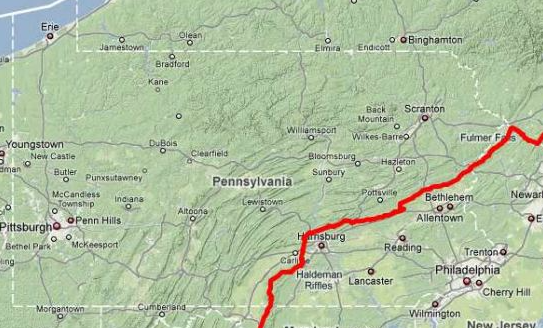
The Appalachian Trail is one of the most renowned long-distance hiking paths in the world. Here’s an expanded overview of the trail, with a focus on its characteristics, history, and the experience it offers to hikers.
Overview:
Length and Location:
- The Appalachian Trail spans approximately 2,200 miles.
- It stretches from Springer Mountain in Georgia to Mount Katahdin in Maine, passing through 14 U.S. states.
Key Characteristics:
Terrain:
- The trail offers diverse terrains including mountains, forests, and meadows, providing hikers with a variety of experiences.
- In Pennsylvania, it is known for its rocky paths, which can be challenging for hikers.
Wildlife and Nature:
- Hikers can encounter various wildlife species, lush vegetation, and a plethora of native plants.
- It offers an immersive experience in nature, far removed from the hustle and bustle of city life.
Historical Context:
Origins:
- The idea for the trail was proposed in 1921 by Benton MacKaye, a forester and conservationist.
- The trail was completed in 1937 and has since been maintained by numerous state and local agencies as well as the Appalachian Trail Conservancy.
Hiking Experience:
Thru-Hiking:
- Some adventurers embark on a "thru-hike," traversing the entire trail in one go, which usually takes 5-7 months.
- Thru-hikers generally start in the south (Springer Mountain, GA) in late winter or early spring and finish in the north (Mount Katahdin, ME) by early autumn.
Section Hiking:
- Others choose to hike specific sections of the trail, which can vary in difficulty and length.
- The trail is marked with white blazes, making it relatively easy to follow.
Shelters and Campsites:
- Along the trail, there are over 250 backcountry shelters and campsites for hikers to rest.
Challenges and Preparations:
Physical and Mental Challenges:
- The trail can be physically demanding, and mental resilience is crucial, especially for thru-hikers.
- Preparing with physical training, route planning, and gear selection is essential.
Safety:
- Hikers should be aware of potential hazards such as wildlife encounters, weather changes, and injuries.
- It’s recommended to hike with a companion or inform someone about your hiking plan for safety.
Community and Culture:
Trail Culture:
- A vibrant community of hikers, volunteers, and enthusiasts who share a deep respect for the trail and each other.
- Trail magic (unsolicited acts of kindness) is a common occurrence, where local residents and previous hikers offer support to current hikers.
The Appalachian Trail is not just a physical journey but also a transformative experience that connects hikers with nature, other enthusiasts, and themselves. Each year, it attracts thousands of hikers from around the world, each seeking their unique adventure and self-discovery.
Recommended: The Best Hiking Boots
2) Ricketts Glen State Park
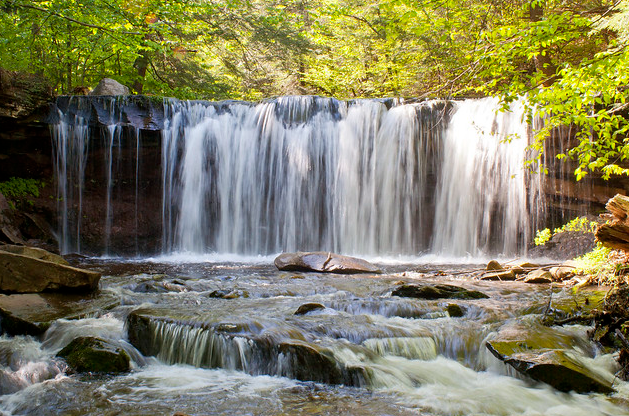
Ricketts Glen State Park is a treasured natural area located in northeastern Pennsylvania, noted for its scenic beauty, abundant wildlife, and extensive trail system. It's renowned for old-growth forests, the Glens Natural Area, and a stunning series of waterfalls.
General Information:
Location:
- Ricketts Glen State Park is situated in Columbia, Luzerne, and Sullivan counties.
- The park spans over 13,000 acres, offering a blend of wilderness and accessibility.
The Falls Trail System:
Waterfalls:
- One of the park’s major attractions is the Falls Trail System, where hikers can view 22 magnificent waterfalls cascading through the two branches of Kitchen Creek as it flows through the Glens Natural Area.
- Ganoga Falls, the tallest waterfall at Ricketts Glen, plunges 94 feet.
Trail Characteristics:
- The Falls Trail is about 7.2 miles long if completing the entire loop, featuring rugged terrains, steep inclines, and rock-strewn pathways.
- The trail can be challenging, especially in wet conditions, requiring hikers to have a reasonable fitness level and appropriate footwear.
Ecology and Wildlife:
Flora:
- The park is home to diverse plant life, including a variety of ferns, wildflowers, and old-growth timber. The forests are composed of eastern hemlock, mixed hardwoods, and white pine.
Fauna:
- Wildlife enthusiasts can spot animals like white-tailed deer, black bears, wild turkeys, squirrels, and an array of bird species. It is a habitat that supports a biodiverse population.
Recreational Activities:
Camping:
- The park offers modern cabins and campsites for visitors looking to extend their stay and immerse themselves in nature.
Fishing and Boating:
- Lake Jean, situated within the park, provides opportunities for fishing and boating, offering another dimension to the visitor’s experience.
Winter Activities:
- During winter, the park transforms into a snowy wonderland, catering to activities like snowmobiling, cross-country skiing, and ice fishing.
Safety and Conservation:
Safety Precautions:
- Due to the challenging nature of the trails, especially the Falls Trail, visitors are advised to take precautions, including wearing sturdy footwear and being mindful of weather conditions.
Conservation Efforts:
- Preservation of the natural ecosystem is paramount. Visitors are encouraged to follow Leave No Trace principles to maintain the park’s pristine condition.
Accessibility:
Accessibility:
- The park is open year-round, but it’s crucial for potential visitors to check the current conditions and any potential closures, especially during the winter months or adverse weather conditions.
Ricketts Glen State Park stands as a testament to the natural beauty preserved in Pennsylvania, offering a serene and visually stunning environment for hikers, nature lovers, and anyone looking to escape the hustle and bustle of everyday life. Each trail and waterfall offers a unique experience, making every visit a new adventure.
3) Presque Isle State Park
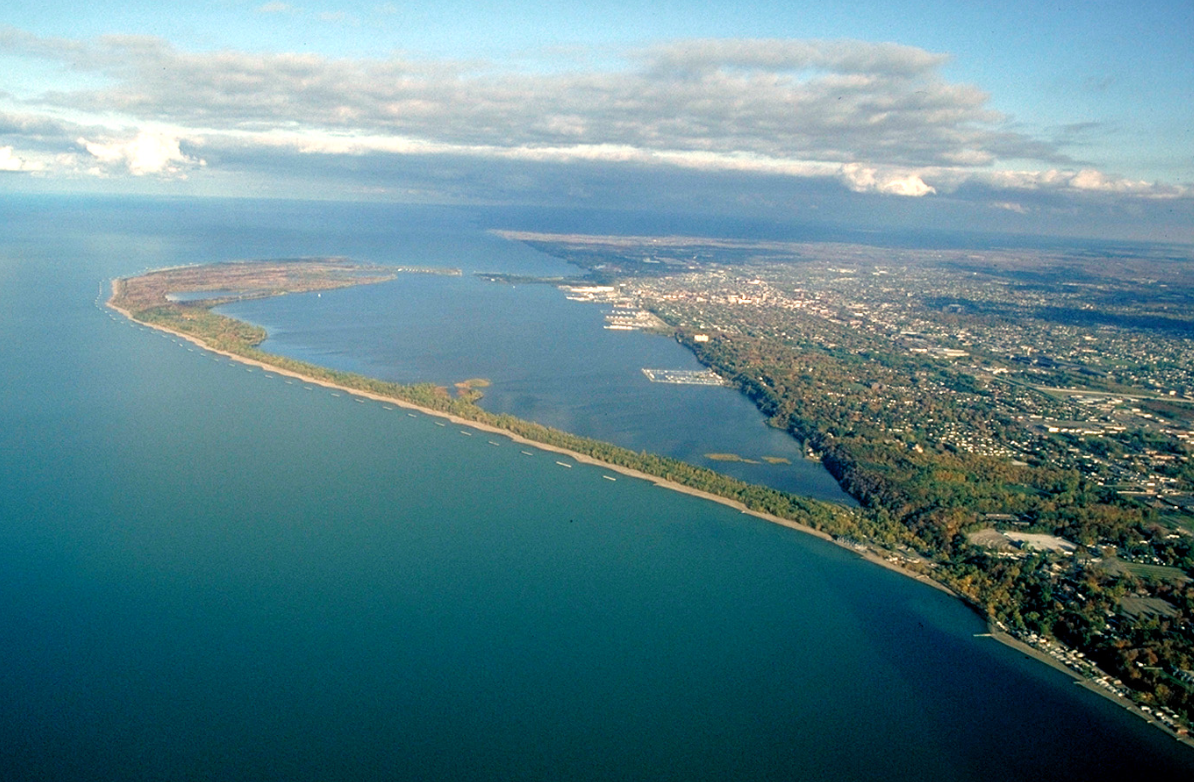
Presque Isle State Park is a natural gem located in Erie, Pennsylvania. It is a 3,200-acre sandy peninsula that arches into Lake Erie, offering a unique blend of natural beauty and recreational activities. Here's a more detailed look at what makes this park special.
Natural Landscape:
Geography:
- Presque Isle is known for its distinctive shape, featuring a series of beaches, marshes, and forests. It’s a dynamic landscape, continually reshaped by the waves and winds of Lake Erie.
Flora and Fauna:
- The park boasts a rich biodiversity, with various habitats that support hundreds of species of plants and animals. It’s a crucial stopover for migratory birds, making it a haven for birdwatchers.
Recreational Activities:
Swimming and Sunbathing:
- With 11 beautiful beaches along the Lake Erie shoreline, visitors flock to Presque Isle for swimming, sunbathing, and picnicking during the warmer months.
Hiking and Biking:
- More than 11 miles of multi-use trails wind through different landscapes in the park, offering opportunities for hiking, jogging, and biking while enjoying picturesque views.
Boating and Fishing:
- Lake Erie and the lagoons within the park provide excellent boating, kayaking, and fishing opportunities. The lake is renowned for its walleye and perch fishing.
Environmental Education and Events:
Tom Ridge Environmental Center (TREC):
- Serving as the gateway to Presque Isle, TREC offers interactive exhibits, educational programs, and a 75-foot observation tower that provides panoramic views of the park.
Annual Events:
- The park hosts a variety of events, including the Discover Presque Isle festival, multi-sport races, and other community activities celebrating the natural and cultural heritage of the area.
Conservation Efforts:
Ecosystem Management:
- Given its dynamic and sensitive ecosystems, ongoing efforts are in place to manage and protect the park’s natural resources, addressing issues like erosion, habitat restoration, and invasive species control.
Wildlife Protection:
- Specific areas of the park may be temporarily closed to protect nesting birds and other wildlife, underscoring the commitment to preserving biodiversity.
Visitor Information:
Accessibility:
- Presque Isle is accessible year-round, with each season offering a distinct experience, from summer beach outings to winter sports like cross-country skiing and ice fishing.
Facilities and Amenities:
- The park is equipped with various amenities, including picnic areas, restrooms, pavilions, and marinas to enhance the visitor experience.
Presque Isle State Park is a destination where natural beauty, recreational enjoyment, and environmental education converge. It's a place of retreat and adventure, inviting visitors to explore its diverse landscapes, observe its abundant wildlife, and engage in the multitude of activities it offers while basking in the serene backdrop of Lake Erie.
4) Delaware Water Gap National Recreation Area
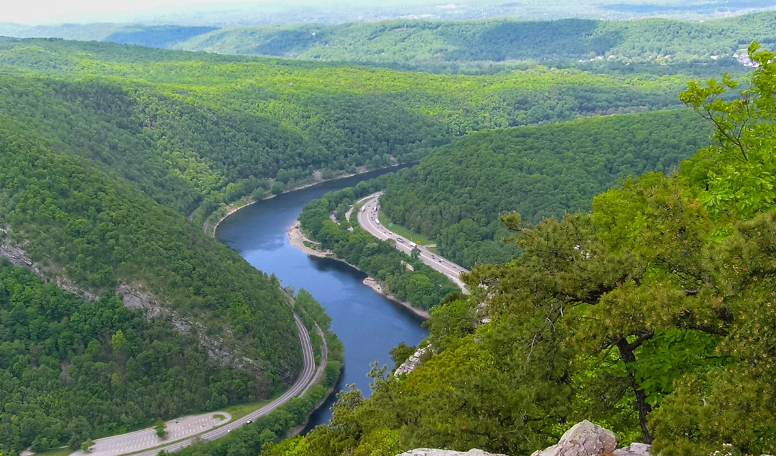
The Delaware Water Gap National Recreation Area is a beautiful region straddling the border of New Jersey and Pennsylvania. It encompasses the Delaware Water Gap, a stunning geological formation carved by the Delaware River, and protects over 70,000 acres of forests, mountains, wetlands, and waterways. Below is an in-depth overview of this iconic area:
Natural Features:
Delaware River:
- The river plays a pivotal role in shaping the landscape of the recreation area, offering opportunities for various water activities and supporting diverse ecosystems.
Water Gap:
- A spectacular natural feature where the Delaware River cuts through the Kittatinny Ridge, creating picturesque vistas and landscapes.
Forests and Wildlife:
- The area is covered in lush forests and is home to a wide array of wildlife, including deer, bears, eagles, and numerous bird and fish species.
Recreational Activities:
Hiking:
- Offering over 100 miles of hiking trails, visitors can explore the scenic beauty, including waterfalls, vistas, and dense woodlands.
Water Activities:
- The Delaware River provides opportunities for canoeing, kayaking, fishing, and swimming, making it a popular destination for water enthusiasts.
Camping:
- Various campgrounds and backcountry camping opportunities allow visitors to immerse themselves in the natural surroundings.
Cultural and Historical Sites:
Millbrook Village:
- A reconstructed 19th-century village providing insights into the lives of the early settlers in the region.
Minisink Archeological Site:
- Offers a glimpse into the history of Native American communities that once inhabited the area.
Visitor Experience:
Scenic Drives:
- Roads like Old Mine Road, one of the oldest in the country, offer stunning drives with panoramic views of the surrounding landscapes.
Educational Programs:
- The park rangers organize various programs to educate visitors about the natural and cultural heritage of the area.
Environmental Conservation:
Biodiversity:
- The recreation area supports diverse habitats, including floodplains, forests, and grasslands that are home to various species of flora and fauna.
Preservation Efforts:
- Active measures are in place to protect and preserve the natural, cultural, and historical resources within the area.
Planning Your Visit:
Accessibility:
- The area is open year-round, with different seasons offering varied and unique experiences, from vibrant fall foliage to serene snow-covered landscapes in winter.
Amenities:
- Well-maintained facilities, including visitor centers, picnic areas, and restrooms, ensure a comfortable visit.
Safety:
- Visitors are advised to follow safety guidelines, particularly when engaging in water activities or hiking, to ensure a safe and enjoyable experience.
The Delaware Water Gap National Recreation Area is a sanctuary for nature lovers, outdoor enthusiasts, and history buffs alike. With its majestic landscapes, abundant recreational opportunities, and rich cultural heritage, it stands as a testament to the diverse and dynamic character of America’s natural beauty. Each visit promises a blend of adventure, learning, and the rejuvenating power of nature.
Recommended: The Best Hiking Boots
5) Loyalsock Trail
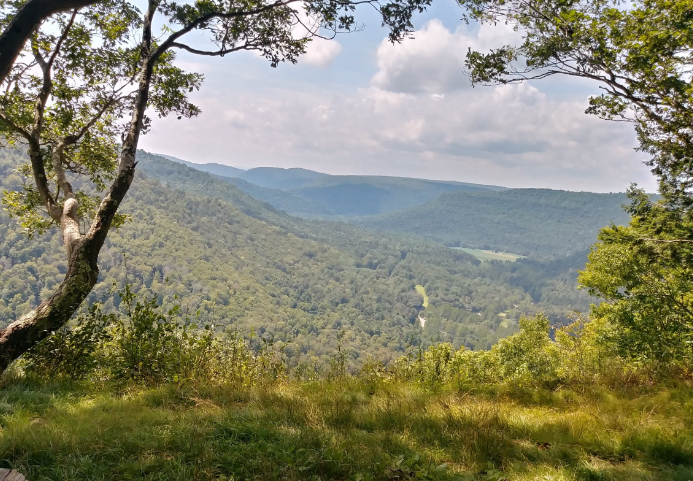
The Loyalsock Trail is a renowned footpath in North Central Pennsylvania, known for its picturesque landscapes, challenging terrains, and the beautiful Loyalsock Creek, from which the trail gets its name. Here's a detailed look at this iconic trail:
Trail Overview:
Length and Location:
- The Loyalsock Trail is approximately 59 miles long, extending through the Loyalsock State Forest and parts of the surrounding areas.
Terrain and Landscape:
- The trail takes hikers through a diverse array of landscapes, including dense forests, rocky canyons, waterfalls, and sweeping vistas of the Endless Mountains region.
Markers:
- It is well-marked with painted yellow discs with red LT letters, making navigation relatively straightforward.
Hiking Experience:
Difficulty Level:
- The trail is rated as moderate to strenuous, with some steep climbs, rocky terrains, and wet sections that can be challenging but rewarding.
Major Highlights:
- Notable features include the Loyalsock Creek, Alpine Views, the Haystacks—unique rock formations in the creek, and numerous waterfalls and scenic overlooks.
Camping:
- There are various primitive campsites along the trail for overnight stays, allowing hikers to immerse themselves in the wilderness.
Flora and Fauna:
Wildlife:
- The trail is home to a wide variety of wildlife, including deer, bears, birds, and smaller mammals, offering opportunities for wildlife observation.
Plant Life:
- Hikers will encounter diverse vegetation, including hardwood forests, hemlocks, mountain laurels, and a variety of wildflowers, especially in spring and early summer.
Safety and Preparation:
Weather Considerations:
- Weather can be unpredictable, so hikers should be prepared for changing conditions, especially during the shoulder seasons.
Equipment:
- Proper hiking boots, water purification systems, maps, and other hiking essentials are recommended to ensure a safe and enjoyable experience.
Trail Etiquette:
- As with any wilderness area, practicing Leave No Trace principles is essential to preserving the natural beauty and ecosystem of the trail.
Accessibility and Regulations:
Trail Access:
- The trail can be accessed at various points, with the most common starting points being either the eastern terminus near Williamsport or the western terminus near Forksville.
Regulations:
- There are guidelines and regulations in place to protect both the environment and hikers, so it’s essential to familiarize yourself with these before embarking on a hike.
The Loyalsock Trail offers an enchanting mix of natural beauty, solitude, and adventure. Each section of the trail unfolds a new chapter of the diverse ecosystems and landscapes of Pennsylvania. Whether you're a seasoned hiker looking for a multi-day adventure or an outdoor enthusiast seeking a day hike with breathtaking views, the Loyalsock Trail promises an unforgettable experience with nature.
6) Ohiopyle State Park
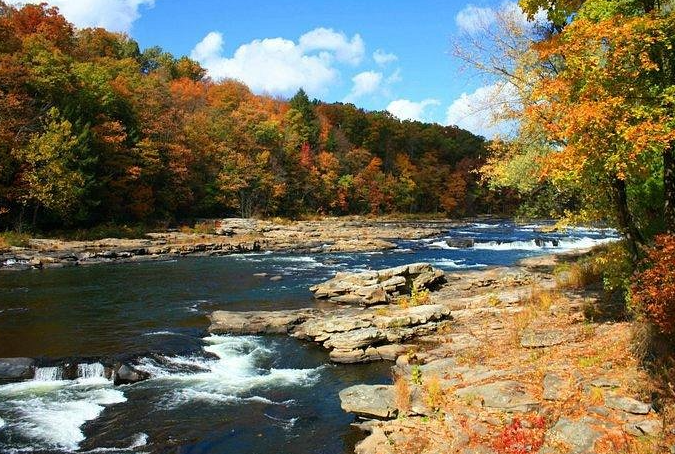
Ohiopyle State Park is a remarkable destination that encompasses approximately 20,500 acres of rugged natural beauty in the Laurel Highlands of Pennsylvania. It is famed for its cascading waters, scenic vistas, and various outdoor recreational opportunities.
Natural Features:
Youghiogheny River:
- The park is centered around the Youghiogheny [yaw-ki-GAY-nee] River Gorge, providing white-water boating and remarkable scenery.
Waterfalls:
- Ohiopyle is home to stunning waterfalls including Ohiopyle Falls, a massive 20-foot waterfall that flows right through the heart of the park.
Flora and Fauna:
- The park boasts a rich biodiversity, with lush forests, abundant wildlife, and a variety of plant species, making it a paradise for nature lovers.
Recreational Activities:
White-Water Rafting and Kayaking:
- The Youghiogheny River provides some of the best white-water boating experiences in the Eastern United States. It caters to both novices and experienced adventurers.
Hiking and Biking:
- Ohiopyle offers over 79 miles of hiking trails and 27 miles of biking trails, including a section of the Great Allegheny Passage, offering scenic vistas and wildlife viewing opportunities.
Rock Climbing:
- The park’s rugged terrains provide rock climbing opportunities for enthusiasts looking to scale its majestic cliffs.
Educational and Interpretive Programs:
Visitor Centers:
- Facilities like the Ohiopyle State Park Office and Laurel Highlands Falls Area Visitor Center offer educational exhibits, maps, and resources for visitors.
Guided Tours and Workshops:
- Throughout the year, the park offers various educational programs, guided tours, and workshops to educate visitors about the area’s natural and cultural heritage.
Camping and Accommodation:
Campsites:
- The park offers modern campsites, equipped with necessary amenities for those looking to extend their stay and immerse in the natural surroundings.
Nearby Lodging:
- There are also nearby inns, bed and breakfasts, and rental cabins for those preferring more comfort.
Conservation and Preservation:
Environmental Stewardship:
- Efforts are consistently made to conserve the park’s ecosystems, protect wildlife habitats, and preserve its pristine beauty.
Visitor Responsibilities:
- Visitors are encouraged to practice Leave No Trace principles to minimize their impact on the environment.
Seasonal Attractions:
Summer:
- Summertime unveils the park’s lively side with bustling trails, white-water adventures, and ideal conditions for camping and picnicking.
Fall:
- The transformation of foliage into vibrant colors makes fall a picturesque season to explore Ohiopyle’s scenic trails.
Winter:
- The park transforms into a winter wonderland, accommodating activities like cross-country skiing, snowshoeing, and sledding.
Ohiopyle State Park embodies the harmonious blend of natural splendor, outdoor adventure, and serene escape, making it a cherished destination for visitors from near and far. Each visit promises a reconnection with nature, marked by the roar of waterfalls, the tranquility of wooded paths, and the invigorating rush of the Youghiogheny’s rapids.
7) Cook Forest State Park
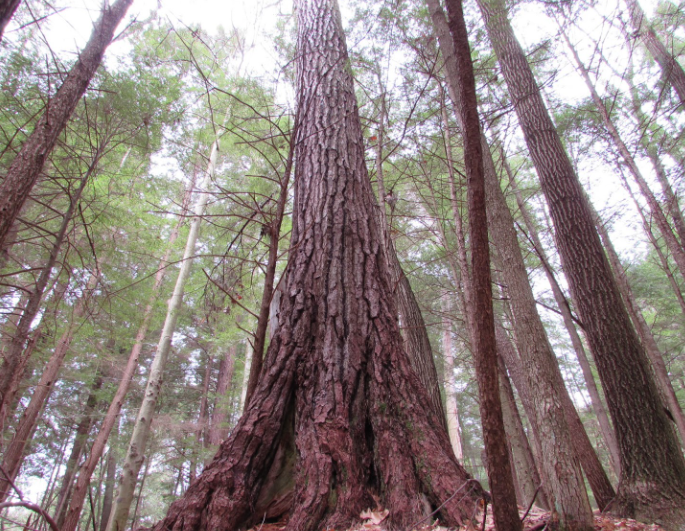
Cook Forest State Park is a pristine natural oasis located in Clarion, Forest, and Jefferson counties in Pennsylvania. The park is renowned for its stands of old growth forest, a diversity of wildlife, and the scenic Clarion River. Below is a comprehensive examination of the park’s offerings.
Natural Beauty:
Old Growth Forest:
- The park is home to the "Forest Cathedral," a magnificent stand of old growth white pine and hemlock trees. Some of these towering giants are over 350 years old and reach heights of more than 200 feet.
Clarion River:
- The Wild and Scenic Clarion River runs alongside the park, offering a picturesque backdrop and opportunities for a variety of water-based recreational activities.
Flora and Fauna:
- Cook Forest State Park is rich in biodiversity, providing a habitat for a variety of plant species, wildlife, and birds.
Outdoor Activities:
Hiking:
- With over 47 miles of hiking trails, visitors can explore the enchanting woods, observe wildlife, and take in views of the beautiful Clarion River.
Canoeing and Kayaking:
- The Clarion River provides excellent conditions for canoeing and kayaking, and the serene environment offers a peaceful escape into nature.
Fishing:
- Anglers can enjoy fishing in the Clarion River, where trout, bass, and other fish species are abundant.
Picnicking:
- Multiple picnic areas equipped with tables and grills are scattered throughout the park for families and groups to enjoy.
Educational and Interpretive Programs:
Environmental Education:
- The park offers a range of educational programs aimed at helping visitors understand, appreciate, and preserve the natural environment.
Guided Walks:
- Park rangers and naturalists often conduct guided walks to explore and learn about the park’s unique ecosystems, especially the old growth forest.
Camping and Accommodation:
Campsites:
- The park features a variety of camping options, including tent sites, cabins, and group camping areas to cater to different preferences.
Amenities:
- Modern facilities including restrooms, shower houses, and a camp store ensure that visitors have a comfortable stay.
Conservation Efforts:
Preservation:
- Dedicated efforts are made to preserve the integrity of the old growth forest and the surrounding ecosystems, ensuring they continue to thrive.
Wildlife Management:
- Initiatives are in place to protect the diverse wildlife that calls the park home.
Visitor Experience:
Seasonal Activities:
- Each season brings a new charm to Cook Forest State Park, from blooming wildflowers in spring, lush greenery in summer, colorful foliage in fall, to a peaceful snowy landscape in winter.
Trails for All Levels:
- Trails vary in difficulty, ensuring that visitors of all ages and fitness levels can enjoy hiking and exploring the natural surroundings.
Cook Forest State Park stands as a testament to the timeless beauty of nature. Its ancient trees whisper tales of centuries past, while the serene Clarion River flows gracefully, inviting visitors to pause and appreciate the enchanting harmony of nature. Whether seeking adventurous outdoor pursuits or a tranquil escape, visitors to Cook Forest are rewarded with an experience that lingers in the soul long after the journey home.
Recommended: The Best Hiking Boots
8) Pine Creek Gorge
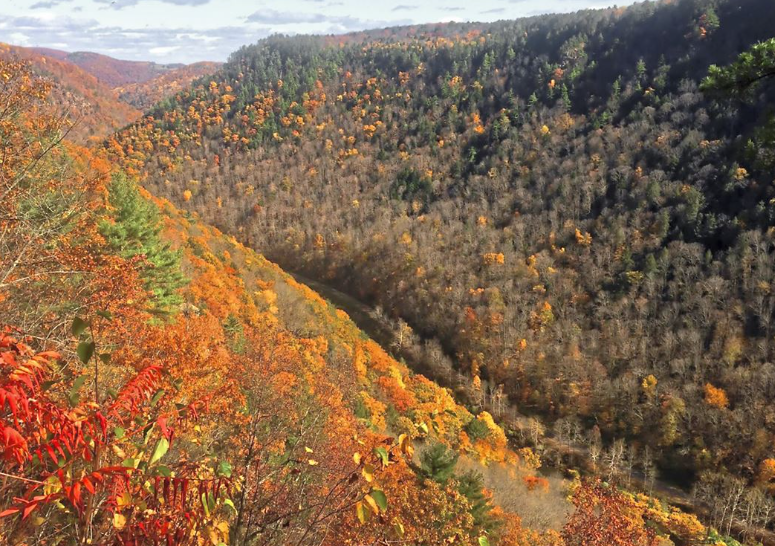
Pine Creek Gorge, also known as the Grand Canyon of Pennsylvania, is a stunning natural landmark characterized by its deep gorge carved by Pine Creek. Located in the Tioga State Forest, the gorge is celebrated for its panoramic views, abundant wildlife, and various recreational opportunities.
Natural Features:
Gorge Formation:
- Pine Creek Gorge extends for about 47 miles, with depths reaching approximately 1,450 feet. The gorge's formation results from millions of years of erosion by Pine Creek, sculpting the breathtaking landscape.
Vegetation and Wildlife:
- The area is densely forested, home to a variety of tree species, including eastern hemlock, pine, and hardwoods. Wildlife such as white-tailed deer, black bears, turkeys, and an array of bird species inhabit the region.
Recreational Activities:
Hiking:
- There are numerous hiking trails of varying difficulties offering magnificent views of the gorge, the surrounding forests, and wildlife.
Biking:
- The Pine Creek Rail Trail runs along the floor of the gorge, providing a flat, accessible path for biking, jogging, and walking amidst a scenic backdrop.
Fishing:
- Pine Creek is renowned for its excellent fishing opportunities, especially trout fishing, attracting anglers from near and far.
Camping:
- Several campgrounds and primitive campsites are scattered around the area for visitors looking to immerse themselves in the serene natural environment.
Scenic Overlooks:
Leonard Harrison State Park and Colton Point State Park:
- These two state parks are located on opposite rims of the gorge, offering exceptional vantage points, picnic areas, and trail access.
Observation Platforms:
- Various platforms provide visitors with opportunities to safely observe and photograph the breathtaking landscapes of the gorge.
Educational and Interpretive Programs:
Visitor Centers:
- Visitor centers offer educational materials, exhibits, and programs that enrich the knowledge of guests about the area's natural and cultural heritage.
Guided Tours:
- During the warmer seasons, park rangers and naturalists often lead guided tours to explore the park’s unique ecosystems and geological features.
Conservation Efforts:
Protection of Ecosystems:
- Conservation efforts are ongoing to protect the delicate ecosystems, promote biodiversity, and ensure that the pristine condition of the gorge and its surroundings is maintained.
Visitor Guidelines:
- Visitors are encouraged to adhere to guidelines and regulations established to minimize human impact on the environment.
Visitor Experience:
Seasonal Beauty:
- Each season unveils a distinct charm, with spring and summer bringing lush greenery, fall showcasing a riot of colors from the changing foliage, and winter offering a tranquil, snowy landscape.
Accessibility:
- Though remote, the gorge is accessible and offers well-maintained facilities and trails to enhance the visitor experience.
Pine Creek Gorge remains one of Pennsylvania's most treasured natural landmarks. The interplay of the steep canyon walls, the flowing Pine Creek, and the surrounding lush forests creates a harmonious and tranquil environment. For nature enthusiasts, outdoor adventurers, and those seeking a peaceful retreat, the Grand Canyon of Pennsylvania offers an unforgettable experience marked by awe-inspiring vistas and the gentle whispers of nature’s timeless beauty.
9) Rothrock State Forest

Rothrock State Forest is a substantial natural area covering over 96,000 acres in central Pennsylvania, offering an abundance of recreational and conservation activities. It is named after Dr. Joseph Trimble Rothrock, a key figure in the establishment of the Pennsylvania state forest system, and is known for its mixed hardwood and coniferous forests, mountainous terrain, and beautiful vistas.
Natural Features:
Terrain and Landscape:
- Rothrock State Forest is characterized by its rugged mountainous terrains, vast woodlands, and numerous streams and creeks, providing a diverse habitat for various wildlife and plant species.
Flora and Fauna:
- The forest is home to a rich biodiversity, including deer, turkey, black bears, and a variety of bird species. The lush vegetation consists of mixed hardwoods, hemlocks, and mountain laurels.
Recreational Activities:
Hiking:
- The forest offers a complex system of trails for hiking, with routes suitable for both novice walkers and experienced hikers. The trails meander through dense forests, open meadows, and along ridgelines, offering panoramic views.
Mountain Biking and Horseback Riding:
- Rothrock is popular for its extensive network of multi-use trails that cater to mountain bikers and horseback riders alike, providing a diverse and exciting terrain.
Camping:
- For those wishing to extend their stay, various camping options, from established campgrounds to primitive backcountry sites, are available.
Fishing and Hunting:
- Streams teeming with trout attract anglers, while the vast expanses of the forest provide ample opportunities for hunting, adhering to the state’s game regulations.
Environmental Conservation:
Forest Management:
- Active forest management practices are in place to ensure the health and sustainability of the ecosystem, including controlled burns, timber harvesting, and reforestation projects.
Wildlife Habitat:
- Efforts to maintain and enhance wildlife habitats include creating food plots, managing old fields, and maintaining wetlands.
Educational Opportunities:
Environmental Education:
- The forest provides educational opportunities for visitors to learn about natural ecosystems, conservation efforts, and local flora and fauna through self-guided trails, interpretive signs, and programs.
Research:
- It also serves as a location for research on various environmental and ecological topics, offering insights into forest dynamics, wildlife management, and conservation.
Visitor Experience:
Accessibility:
- Different areas of the forest are easily accessible, with well-maintained trails, parking areas, and facilities to ensure a comfortable experience for visitors.
Seasonal Attractions:
- Each season offers a unique charm at Rothrock. Spring brings wildflowers; summer, lush greenery; fall showcases a tapestry of colors, and winter transforms the landscape into a peaceful snowy retreat.
Safety and Regulations:
- Visitors are encouraged to familiarize themselves with safety guidelines and regulations to ensure a safe and enjoyable experience while minimizing their impact on the environment.
Rothrock State Forest is not just a destination for outdoor enthusiasts, but a sanctuary where the harmony of nature is vividly on display. The rustling leaves, flowing streams, and tranquil paths invite visitors to step away from the bustle of daily life and immerse themselves in the serene and timeless beauty of nature. Each visit, marked by discoveries and the quiet majesty of the woods, enriches the soul and instills a profound appreciation for the natural world.
10) Schuylkill River Trail

The Schuylkill River Trail is a renowned multi-use trail in Pennsylvania, offering pedestrians, cyclists, joggers, and other outdoor enthusiasts a well-maintained path along the scenic Schuylkill River. Below is an in-depth perspective on this delightful trail.
Trail Features:
Length and Location:
- The Schuylkill River Trail, when complete, will span over 140 miles, from Frackville in Schuylkill County to Philadelphia. As of my last update, various segments are complete and interconnect various communities.
Terrain and Scenery:
- This relatively flat trail offers views of the serene Schuylkill River, urban landscapes, historical sites, and natural beauty, providing a varied and enjoyable experience.
Art and Historical Markers:
- The trail is peppered with art installations and markers that educate visitors on the history and ecology of the area.
Recreational Activities:
Walking and Cycling:
- The trail is popular for walking, jogging, cycling, and even in-line skating, offering recreational opportunities for people of all ages and fitness levels.
Fishing and Bird Watching:
- Proximity to the river allows for fishing, and the diverse habitats along the trail make it a good spot for bird watching.
Events:
- Various events like marathons, festivals, and community clean-ups are often organized along different sections of the trail.
Educational and Interpretive Programs:
Informational Signage:
- There is informational signage offering insights into the wildlife, flora, and historical significance of the areas surrounding the trail.
Environmental Education:
- Programs and workshops are occasionally organized to educate the public on environmental conservation and the Schuylkill River's ecology.
Accessibility and Amenities:
Trail Access:
- The trail is easily accessible from numerous entry points, each offering parking and close proximity to local amenities.
Facilities:
- Amenities like restrooms, benches, and picnic areas are available along various segments of the trail, enhancing the visitor experience.
Conservation Efforts:
Maintenance and Restoration:
- Active efforts are made to maintain, restore, and enhance the trail, involving community participation and organizations dedicated to the trail’s upkeep.
Wildlife Preservation:
- Sections of the trail offer insights into local wildlife, and efforts are in place to preserve and protect these natural habitats.
Visitor Experience:
User-Friendly:
- The trail is user-friendly, with clear markings and maps available for navigation. It accommodates users of various abilities and is wheelchair accessible in many sections.
Seasonal Beauty:
- Each season unveils a new aspect of beauty along the trail, making it a year-round destination for outdoor enjoyment.
Community Engagement:
- The trail not only offers a recreational outlet but also fosters community engagement, wellness, and an appreciation for the natural and historical heritage of the Schuylkill River area.
The Schuylkill River Trail is more than a pathway—it’s a journey through the diverse landscapes, histories, and communities that line the banks of the Schuylkill River. Every step, pedal, or jog along this trail is an exploration of the rich tapestry of nature, culture, and the invigorating spirit of outdoor adventure.
Recommended: The Best Hiking Boots
Wrapping Things Up
In wrapping up this exploration of Pennsylvania's hiking and outdoor gems, it’s apparent that the Keystone State is a haven for nature enthusiasts, hikers, and adventurers alike. Each trail and park, from the iconic Appalachian Trail to the serene pathways of Rothrock State Forest, offers a unique blend of natural beauty, wildlife, and historical richness. The scenic landscapes of Pine Creek Gorge and the mesmerizing waterfalls of Glen Onoko (when it was accessible) echo the diverse and captivating allure of Pennsylvania’s outdoors.
The trails aren’t just pathways woven through the woods, alongside rivers, and over mountains—they are gateways to experiencing the profound tranquility, awe, and exhilaration that only nature can inspire. Each route provides a distinct narrative of ecology, history, and conservation, offering visitors not just a physical journey, but an emotional and educational odyssey as well.
As we step into the embrace of the wilderness, amidst the towering trees of Cook Forest State Park or along the tranquil banks of the Schuylkill River, there’s a rekindling of a primitive, profound connection to the natural world. It’s a reminder of the intrinsic value of preservation and respect for the environment, ensuring these natural sanctuaries continue to thrive for generations to come.
In every rustling leaf, every cascading waterfall, and every panoramic vista that stretches towards the horizon, there’s an invitation to step away from the clamor of everyday life and into a world where nature narrates tales of timeless beauty, resilience, and harmony. Whether you’re a seasoned hiker or a casual nature lover, Pennsylvania’s trails await—to both challenge and charm, to educate and inspire, and to offer the soulful solace that is found in the heart of nature’s embrace.
